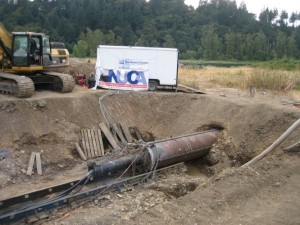 In November, 2013 Armin W. Stuedlein, PhD, PE and Tadesse Meskele of the Geotechnical Engineering Group, School of Civil and Construction Engineering at Oregon State University completed a research project on pipe ramming installations for the Oregon Department of Transportation and the Federal Highway Administration.
In November, 2013 Armin W. Stuedlein, PhD, PE and Tadesse Meskele of the Geotechnical Engineering Group, School of Civil and Construction Engineering at Oregon State University completed a research project on pipe ramming installations for the Oregon Department of Transportation and the Federal Highway Administration.
Background: Culverts are an essential component of roadway drainage systems that transport storm runoff and stream channels from one side of a road to the other. The majority of culverts installed in the 1950s and 1960s are reaching the end of their functional lives and need replacement due to structural deterioration, scour, corrosion, erosion, separation, or increased hydraulic requirements.
The traditional open cut method is the most widely used method for installation or rehabilitation of underground pipelines, conduits, and culverts. However, the open-cut method requires time-consuming excavation, installation and back-filling, which can impose an adverse impact on the daily life of society by creating road or rail closures, traffic delays, detours, loss of access to homes and businesses, and undesirable noises (Ariaratnam et al. 2006). Thus, engineers and contractors are gradually abandoning open trench cutting and embracing trenchless methods of pipe installation. These trenchless methods can mitigate many of the logistical issues associated with traditional approaches. In particular, pipe ramming, which is a simple non-steerable trenchless construction technique, is becoming an emerging method of pipe installation, because it allows installation of casings in soils with large cobbles and boulders, which are ground conditions that may pose greater difficulty to other trenchless techniques. Pipe ramming is also a commonly chosen technique for shallow pipe or culvert installation under roads and railways, where other trenchless methods could cause unacceptable ground settlement or heave.
Need for this Research: Despite the growing popularity and experience with pipe ramming, there is surprisingly little technical guidance available for engineers to plan pipe ramming installations appropriately. Stuedlein and Meskele presented a preliminary, baseline engineering framework for the design of pipe ramming installations.
Objectives of the Study: The main objective of this research is to study the mechanics of pipe ramming and to develop a rational engineering framework for the optimal design and specification of pipe ramming installations.
To learn more about this research and to read the full report click here.
Thank you to School of Civil and Construction Engineering, Oregon State University for providing this content and photo. Photo info: Pipe ramming performed at an experimental test site for the OSU research project. This test ram was made possible in part by members of the NUCA of Southwest Washington and Oregon.
